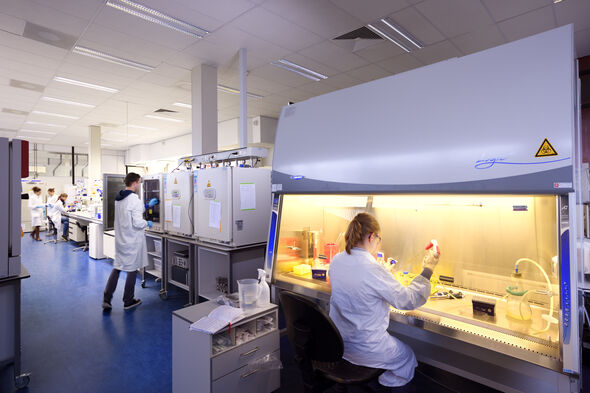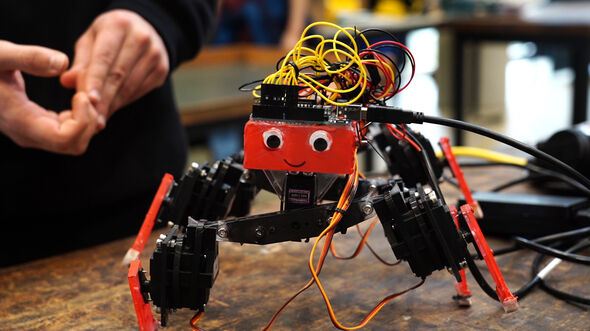
Is everything ready for Bachelor College 2.0?
Program directors tell us about their experiences with the redesign
Before we head off for the summer holidays, Cursor would like to update you on the Bachelor College 2.0, which will be starting in September. And who better to ask about this than the program directors, who put so much time and energy into this over the past years. We submitted eight questions to each of them and with the answers six of them provided we’ve tried to paint an accurate picture of the current state of affairs. This first part looks at the impact the redesign has had on the curricula, the way Challenge-Based Learning (CBL) has been incorporated, what has happened to the basic courses and what the assessments will look like.
Over the past few years, a lot of hard work has gone into redesigning the Bachelor College, which was introduced at TU/e in 2012 under the supervision of the first dean, Lex Lemmens. Nowadays – even more than before – our education is constantly being finetuned, and it’s no different for this eleven-year-old teaching model for the TU/e bachelor’s programs. Which shouldn’t come as a surprise, as all kinds of developments, such as the continuing digitization of education, and new didactic insights mean universities are constantly forced to explore and test whether new concepts and educational methods are even better suited to prepare students for their transition into society. At the beginning of March, Ines Lopez Arteaga, who succeeded Lemmens as dean of the Bachelor College in 2020, told Cursor that "our bachelor's education will always be evolving.”
Six program directors describe how they adapted their curriculums, how drastic these changes were, what alternatives have been developed for the interim tests and what the decision to no longer offer basic courses has meant for their programs.
Hans Kuerten (Mechanical Engineering/ME), Mark van den Brand (Mathematics & Computer Science/M&CS), Henk Swagten (Applied Physics & Science Education/AP&SE), Jacob Voorthuis (Built Environment/BE), John van der Schaaf (Chemical Engineering & Chemistry/CE&C) and René van Donkelaar (Biomedical Engineering/BME) tell us how they went about things in their respective departments.
Did the transformation from BC 1.0 to BC 2.0 lead to big changes in the curriculum?
Kuerten/ME:“With us, the changes haven’t been that big. We weren’t dissatisfied with our old curriculum and mainly took advantage of the changes for two things. Firstly, we accommodated some areas of knowledge for which there was hardly any room – or no room at all – in the major, such as statistics. Secondly, we used the redesign to increase the coherence within the curriculum.”
Swagten/AP&SE:“There are definitely some big changes. When I started as program director in 2018, the degree programs were already having some issues. We deliberately left those alone until the introduction of BC 2.0. So not only will there be more attention for P&PD (Personal & Professional Development, which will be discussed in more detail next week, ed.) and CBL, and a broader selection of core courses due to the disappearance of the basic courses and the USE learning trajectory, but we’re particularly proud of having a curriculum whose coherence, depth and skill development aspect have improved.”
Van den Brand/M&CS: “At Computer Science, the elimination of the basic courses created space in the first year, which is being filled by moving a few math courses from years 2 and 3 to year 1. One of the current courses is being split in half, resulting in a Networks course and a Security course. We’re also moving around some courses within quarters and/or years. The introduction of an individual final project for this bachelor’s program is the most important change, and dovetailing with that the introduction of three capstone courses that conclude the most important learning trajectories. Those are all changes to year 3.
For Data Science, the curriculum changes are very limited. There will be a new course, Data Acquisition Methods, in the first year. For the rest, we’re talking cosmetic changes.”
Van der Schaaf/CE&C:“Before the redesign, our department was running a pilot because of the large number of changes in the curriculum. In terms of contents, the bachelor’s program is remaining largely unchanged, but it has been redistributed across the different courses and learning trajectories, in most cases supplemented by a practical component. The latter may take the form of lab experiments or computer simulations. About forty percent of first-years will have a practical every day.”
Van Donkelaar/BME: “The contents of the curriculum was fine as it was, so it’s staying pretty much the same. We are shaking everything up a bit, for example by moving a small number of courses for better streamlining and converting some theoretical courses to CBLs entirely. We used a number of basic principles. First, we will now have clearer learning trajectories, which are more recognizable to students. This does require a lot of coordination between teachers, to attune the contents of the different courses. Second, the difference between our two core programs (Biomedical Engineering/BBE and Medical Sciences and Technology/MST) will be more defined. Third, and entailing the biggest changes for our students: DBL is being upgraded to CBL and a hands-on skills experience of 10 ECTS will be added to the first year. Students will be doing four practical assignments, in the areas of biochemistry, imaging, mechanics and data analysis (for which they’ll use their own bodies). Fourth, we are trying to clarify how the curriculum components relate to each other in a coherent way, for example by not offering statistics as an individual course but by integrating it into the skills experience. Lastly, we look for the best way of integrating P&PD, in such a way that students gain an insight into their development.”
Voorthuis/BE:“Our entire curriculum was overhauled, with the aim of having more collaboration and integration between courses and projects, a better link-up to the master’s program and a heavier focus on the first year. We also want to accommodate three student profiles. The ‘digger’: those who want to delve deeply into their field of study; each unit is developing courses to match. Electives are used to provide further depth to this profile. The ‘binder’: those who want to link their disciplinary knowledge to their sincere engagement in one or several societal challenges we are facing. This is paired with electives on sustainability. Students can find these within their own department or at other departments. The ‘climber’: those who want to create a unique profile for themselves to do good and make a difference. These students might combine the Urban Systems and Real Estate (USRE) track with a series of Structural Engineering and Design (SED) electives. With a course package like that, they are also already lining themselves up for doing a double master’s program.”
With our new curriculum we want to accommodate three student profiles: the digger, binder and climber
Challenge-Based Learning (CBL) is an important part of the Bachelor College 2.0. How far along are the programs with this and what will it look like?
Kuerten/ME:“We had already been working on the transition from DBL (Design-Based Learning) to CBL for a few years. A number of teachers had already developed CBL projects, including one in collaboration with the Applied Physics. As a result, we already met the new guidelines with respect to CBL in the old curriculum. In the first year there’s a CBL project every quarter, in the second year three CBL projects are mandatory, and in years 2 and 3 a number of electives take the form of CBL. We’ll continue to develop the CBL projects and try to involve external stakeholders in more projects, thereby making a more explicit connection with major societal issues.”
Swagten/AP&SE:“We started holding discussions on the necessity and the possible role of CBL a few years ago. So we had those, plus education days, teacher-run pilots, and exciting new initiatives, such as a CBL course on control technology of robot systems together with Mechanical Engineering. We developed our own vision of using CBL, which was organically translated to fit the new BC. We added CBL elements to some courses, while other courses are being designed from scratch within the CBL framework, always with a strong link to the development of the skills of our future applied physicists. But more on this skill development later.”
Van den Brand/M&CS: “For Computer Science we’re in the process of developing a new CBL course for the first year. We’re also introducing a number of courses with a CBL component. My biggest concern is the multidisciplinary course in the final quarter of the second year, which still needs to get off the ground. For the Data Sciences bachelor’s program we already had a full-fledged CBL learning trajectory revolving around Data Challenges and we’ll be introducing CBL components to several courses.”
Voorthuis/BE: “Our program comprises the humanities, the exact sciences and the social sciences, so our department is incredibly multidisciplinary by default. In the first year we have a project trajectory in which students spend five ECTS on project education each quarter. The courses in each quarter are thematically linked to project education assignments. The projects are consecutive in nature, which means their complexity increases as the year progresses. In the first year, we combine two disciplines per project. In the second year, students delve deeper into a discipline of their choice and the centrally coordinated CBL project also takes place in that year. In the third year, they do a multidisciplinary project and, possibly, a multidisciplinary graduation project.”
We try to involve external stakeholders in CBL projects, thereby making a more explicit connection with major societal issues
Van der Schaaf/CE&C:“We set up the CBL trajectory in such a way that the students learn to tackle a complex real-world and open-ended challenge in a step-by-step process. Initial challenges are fairly simple and consistent with the theory taught within a course. Once the students are more familiar with everything in the first semester of the second year, the complexity and open-endedness increases. Then, in the second semester of the second year, students work on a multidisciplinary challenge, which focuses on collaborating and communicating with other disciplines. The third year features an open-ended, complex challenge, where students not only work as a group but also manage another group (and vice versa). Our CBL trajectory is concluded with the final bachelor’s project, where each of them has to show that they are able to tackle a project/challenge individually, and that they have the required professional and personal competences.”
Van Donkelaar/BME: “Already from our inception, almost twenty-five years ago, our education has contained a sizeable Design-Based Learning (DBL) component. The step from OGO to CBL isn’t that big, but we’ve taken the opportunity to scrutinize the contents and make a few changes. What’s outdated will disappear, the contents will be more topical, the challenges more open-ended. The CBLs in their entirety will therefore become more interesting and more motivating for students. A number of courses will also include CBL components. We’re already running experiments in this respect, for example in the Applied Cell Biology course. Some courses will transition fully from theory to CBL, such as the one on optics, in which we’ll explain the field while students build their own microscopes from scratch.”
Alternatives have been developed for the interim tests. There will be more focus on interim feedback. How will that turn out in your department?
Kuerten/ME: “We’ve been working on this for a few years already. The traditional interim tests that were introduced in BC 1.0 were increasingly difficult to organize and we didn’t find them very useful from a didactic perspective, because they generally involve next to no feedback. For many courses we had already introduced progress tests, in which feedback is given automatically. Developing this takes time, but it can be partly done by student assistants. Once they’ve been completed, the work involved is very limited, because everything is done digitally and automatically. And interim feedback has always been a feature in the projects.”
Van den Brand/M&CS: “We regularly discuss the changes with the teachers. The feedback can be provided in different ways and supported by tooling where necessary.”
Swagten/AP&SE: “I think we are now offering teachers a greater deal of flexibility to integrate feedback and assessments into their courses in a coherent manner. Which is already happening for most courses. Many different types of education are being provided, each of them with their own mode of feedback to students or between students. The new BC 2.0 guidelines stress the importance of feedback and I of course applaud that.”
Voorthuis/BE: “We are already using many feedback moments and modes. We are actively employing new teaching methods and digital means of testing.”
Van der Schaaf/CE&C: “In the context of right-on-time feedback to students, a new type of interim assessment has been introduced, wherever possible and desirable. This means students get one or more digital tests per course, via SOWISO. They have to take them at some point in the quarter. These tests are graded automatically by SOWISO, so students can see how they did right away.
The sixty percent of first-years not taking a practical have the possibility of taking one of the digital tests in the test-taking room. For the pilot, a test-taking room has been set up in Helix. A proctor will be present to hand out and register the STEP sticks and any loaner laptops, as well as act as a digi coach. Teachers are continuously kept updated of each group’s progression on every digital test, which allows them to devote attention in their lectures to test elements that the students are struggling with. During the supervised self-study sessions, the students can ask questions about both the content and the previously taken digital tests.
We don’t expect this will result in an increased workload for our teachers, but it does take some time to compile the database for each of the digital SOWISO tests. Fortunately, most of the teachers have already built a considerable database over the years and they see the added value of expanding it and implementing it into SOWISO. After all, less time spent on grading means more time for student guidance."
Van Donkelaar/BME: “We already enjoyed quite some freedom when it came to designing tests. Basically, more variation is the only way of avoiding a pile-up of summative interim tests (that you either pass or fail, ed.) at specific moments within the quarter. If this happened, we wouldn’t be able to handle it from an organizational perspective, because there’s no central support for interim tests. That would mean students would have even more hoops to jump through. We can’t have that.”
I do support the aim of combating procrastination, which is why we haven’t called it ‘interim test’ but ‘interim feedback’. Feedback is always useful and can’t be given and received often enough, for example when it comes to CBL. I do have some reservations about the requirement to organize two interim feedback moments for every course. Not every course is suitable for this and it can lead to undesirable side effects. If you carefully think about assessment and use it in the right way, it’s an immensely powerful instrument. But it’s to be expected that there will be extra summative interim tests that don’t contribute much and that detract from hours that used to be devoted to the exchange of information. Well-intended Canvas quizzes that students will quickly find a way around, and artificial types of feedback that make no significant contribution to the learning process. This deserves constant attention and commitment from teachers, quality care staff and program directors at all departments. At the same time, it demands a thorough TU/e-wide evaluation in a few years’ time. Central evaluation in this context would be: ‘Have interim feedback moments decreased procrastination?’; ‘Has it been helpful to the students?’; ‘Does it justify the efforts by the teacher and the organization, or would it be better to put those efforts to use somewhere else?’.”
If you carefully think about assessment and use it in the right way, it’s an immensely powerful instrument
Besides Calculus, will there be any traces of the ‘old’ basic courses left? What is definitely not making a comeback?
Kuerten/ME: “Most of the other basic courses are still reflected in our new curriculum, but with a greater deal of customization to our own field of studies. A few components of Applied Natural Sciences (ANS) will not return in our core courses.”
Van den Brand/M&CS: “Yes, both in the Computer Science and Data Science bachelor’s programs the course Foundations of Data Analytics will be returning. This, as opposed to the ANS contents.”
Swagten/AP&SE: “Calculus really isn’t an exception. It’s no longer a compulsory basic course, but all programs agree to the necessity of having a sound mathematical basis and decided to include it in their cores. We ourselves taught Applied Naturel Sciences (ANS), which had always been somewhat of an issue within our curriculum because our students already get a hefty portion of physics to chew on in the first year. Parts of other basic courses have now been better integrated into our program, such as programming and multidisciplinary collaboration.”
Voorthuis/BE: “Many required skills, such as the ones from ANS, have not been integrated into the new and modified courses. The course on data analytics, for example, will remain a compulsory part of the first-year curriculum. For other tracks it’s an elective.”
Van der Schaaf/CE&C: “In the context of the pilot, the compulsory basic course Calculus will be replaced by ‘Calculus for CE&C’, with contents identical to the basic course ‘Calculus variant B’. But testing will be done by way of interim digital assessment moments.
ANS learning outcomes will be partly included and integrated into the CE&C courses, such as the introduction to chemical bonds and physical transport phenomena. Data Analytics will also be partly included and integrated into the CE&C core courses, such as the introduction to statistics and programming.
The USE-basic and Engineering Design courses will be replaced by ITEC Engineering Ethics and Multidisciplinary CBL, respectively, with the preconditions for taking the latter course being taught as part of CBL Molecules and Materials in the second quarter of the second year.”
Van Donkelaar/BME: “As everyone thought Calculus provided such an important foundation, we’ve kept taking it in droves. USE-basic is the only basic course that is remaining, albeit in a different form (ITEC in year 1 and year 3). Engineering Design is becoming an interdisciplinary CBL in the fourth quarter of the second year. We are preserving the contents of applied sciences, but we’re rolling it back to the physics for BME course that we had before the introduction of the Bachelor College. It’s the same in terms of contents, but it’s a much better match for the interests of our students. Data Analytics is very important for us and will be spread out across a large number of courses, where it will be covered extensively and used in the context of BME applications. This will do it much more justice and will stick with students more as well. In that sense, I’m happy we now have the opportunity to exert greater control of the lay-out of the education we provide.”
Next week in the second part, the program directors will talk about the Personal & Professional Development Program, about the elective space that will be retained for students and about whether they expect if there will be enought teaching spaces and accompanying staff. And finally: how long do they expect TU/e to be able to move forward with this new educational concept?





Discussion